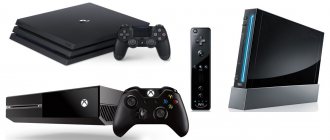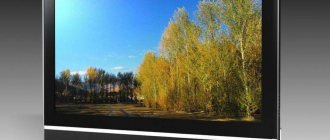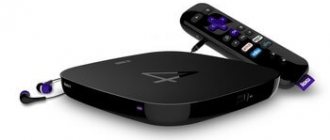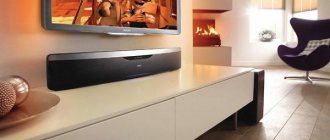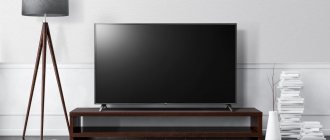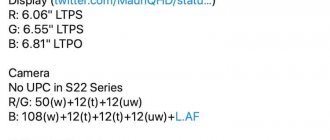A bracket is a mount for a TV. Can be made in different designs. Simple brackets are intended only for normal hanging of equipment in a strictly vertical position. More advanced mounts allow you to tilt and rotate the TV from side to side.
When choosing a bracket, you need to consider some parameters. You should operate not only with the mounting characteristics, but also with the parameters of the TV being installed. It is equally important to consider the room in which you need to hang the TV on the wall with a bracket. Not only the purpose of the room (bedroom, kitchen, living room) plays a role. The choice of fastening is also influenced by the presence of other design elements.
Arm Media LCD-201
Our rating of the best brackets is completed by the Arm Media LCD-201, which is perfect for TVs with a screen diagonal of up to 40 inches. Unlike other participants in this TOP, it has a more compact size, which does not in any way affect its reliability. The bracket can withstand a load of up to 30 kilograms. At the same time, it allows you to adjust the angle of rotation of the TV by 60 degrees horizontally and 20 degrees vertically, which allows its owner to install the TV at the most convenient angle for him to comfortably watch TV shows, movies or sports broadcasts. But due to the peculiarities of its design, this bracket does not allow you to lean the TV close to the wall and it does not have decorative inserts to look better in the interior of the apartment. So it is more suitable for installation in places where it will not be viewed from the side. But if this drawback doesn’t bother you, then Arm Media LCD-201 will be an excellent option for mounting a TV with a screen diagonal of up to 40 inches.
- Tilt-rotary.
- Diagonal: 15 - 40 inches.
- Distance from wall: 90 mm.
- Tilt angle: ±20⁰.
- Rotation angle: 60⁰.
- Max. load: 30 kg.
- VESA holes: up to 200x200 mm.
Types of TV brackets
According to the place of fixation, they distinguish:
- wall;
- ceiling;
- table brackets.
There are four types of factory wall mounts on the market:
- fixed;
- inclined;
- tilt-rotary.
Additionally, we can mention the rack-brackets that are placed on the floor. This is a regular metal structure with fasteners on vertical posts.
For outdated CRT models with a cathode ray tube, a shelf bracket is required. The principle of mounting to the wall is no different, but the TV itself is simply placed on a shelf. For safety, these brackets have a lamp that holds the TV.
Shelf models can also be used for light-weight, thin TVs. There are options with a glass surface.
It is not always necessary to buy the most expensive option with the ability to tilt and rotate television equipment. In many cases a conventional fixed bracket is required. The choice depends on the room where you will watch television.
Fixed
Structurally, it is made of two parts:
- wall mount;
- television
Does not have regulation functions. The TV screen is hung in a strictly perpendicular position relative to the floor.
Suitable for a room where there are no objects that interfere with the installation of the TV. If you hang the TV on a wall with a fixed structure very high, then viewing will become uncomfortable. In addition, high altitude will cause regular neck swelling and eye fatigue during prolonged viewing.
Selected for bedrooms, halls. But provided that there are no high interior items at the installation site - cabinets, fireplaces, etc. Then the installation is done so that the eye level coincides with the center of the screen (living room) or with the lower third (bedroom).
With a fixed design, space is saved as the body rests as tightly as possible against the wall.
Inclined
Externally it is almost identical to the fixed one. But there is an adjustment groove that allows you to tilt the TV up or down.
Suitable for bedrooms and living rooms where there is a tall object in the intended installation location. Then the TV is hung higher and tilted down slightly.
Older models may contain grooves instead of rotating axles to change the angle of inclination. Rearranging the mount increases or decreases the inclination.
Pan-tilt
There are two subspecies:
- with one knee;
- two-knee.
The first may be with a short elbow, which is intended only for adjustment in two axes. Installed in rooms where the TV is located in almost direct line of sight. A common area of application is kitchens.
The long single-arm bracket allows you to move the TV forward and make significant horizontal adjustments. Useful for combined rooms or where the TV is viewed in different places. It will be possible to deploy equipment to almost any point.
The two-leg fastener contains an additional bar, which increases the possibilities of adjustment. The scope of application is identical to the bracket with one elbow.
Such brackets can be hidden in cabinets. Used when installed in the corners of the room.
Not recommended for mounting in a bedroom with a narrow passage between the bed and the wall for two reasons:
- the passage narrows even more, since the bracket takes up significant space behind the TV screen;
- viewing is carried out only from the bed, so adjustment is useless. Just overpay for the complexity and functionality of the design.
Ceiling
Needed if:
- non-standard mounting of equipment is required (for example, right in the center of the room);
- The hanging wall is fragile. Then the TV is fixed through a bracket to the ceiling;
- makes it easier to install in corners.
If the walls are strong, it is better not to use ceiling fasteners.
The standard bracket is always hidden behind the TV body. The ceiling option will always be visible. Over time, the visible bracket can become very annoying.
Desktop
The main purpose is to install monitors at the desktop. They are attached through a clamp - a nut clamp that is pressed against the edge of the table. Therefore, the table surface does not need to be drilled.
How about a homemade bracket
If you are not worried about the design of the bracket on the back of the TV, then you can make your own mount at almost no cost. This makes a lot of sense, since for the simplest fastenings you don’t need to cook or saw anything. And the cost of all parts will not exceed 150-200 rubles.
The factory bracket will still have to be hung on the wall. This means you will need to drill holes in the wall. So why not move away from the idea of spending a lot of money, and build fasteners using a couple of corners and a few bolts.
To create the easiest option you will need:
- two single corners for wall hanging furniture;
- a pair of bolts with nuts and washers of the appropriate diameter for the holes in the corners;
- bolts for the lower mounts so that the screen hangs vertically and not tilted downwards;
- plastic dowels and screws to secure the corners in the wall.
Installation instructions:
- Screw the corners to the upper fasteners on the body of the television receiver.
- Screw the bolts into the lower mounting holes to a length that matches the side of the angle. The bolts from below will rest against the wall, which will prevent the TV from tilting under its own weight.
- Measure the horizontal distance between fasteners.
- Draw a level line on the wall and drill two holes at a certain distance in step 3.
- Drive the expansion dowels into the wall all the way so that the caps do not protrude.
- Screw the corners with screws.
- Screw the bolts into the holes on the protruding sides of the corners so that the caps point down and the pin points up.
- Attach the TV corners to the bolts in the wall corners.
If the distance between the TV and the wall is not enough to properly insert the antenna cable, then use a V-shaped adapter.
conclusions
When choosing a bracket for television equipment, you need to remember the following nuances:
- Experts call the main criteria for choosing the type of bracket, the maximum load it can withstand, as well as the diagonal of the screen ;
- special attention should be paid to the size of the mount according to the Vesa standard - the manufacturer indicates this information in the technical description of the design;
- to avoid chafing of electrical wires and their tangling, you should give preference to a model with a well-thought-out system for laying the network cable in a separate compartment ;
- For ease of installation and subsequent alignment of the display, it is better to purchase a bracket with a built-in level.
Additional factors when choosing
- Availability of external closing elements in the package. A bracket is a set of painted metal parts together. Some configurations also have plastic parts for the outer skin.
- Circular rotation option. Nowadays televisions are being produced that can show the picture in a vertical position. If the function is in demand by you, then it is better to choose a TV bracket with the ability to turn the equipment over.
- Electric drive with remote control. If you often move from one place to another, then changing the position of the equipment with your hands is inconvenient. There are models that have an electric drive. Consists of a driving motor and a circuit for wireless remote control.
- Wire management system. The bracket may have fastenings for outgoing cables from other devices or the same network cable plugged into an outlet. This way you don’t have to wrap the bracket with wire or fix it with electrical tape or tape to prevent it from drooping.
- Possibility to hang a larger or smaller diagonal. If you know for sure that you are going to buy a new TV receiver in the future, then it is better to choose a universal bracket that has holes for different sizes of mounts.
Comparison of the best models
| Model | Type | Minimum and maximum VESA standard, mm | Maximum load, kg | Minimum distance to wall, mm | Price, rubles |
| Kromax Techno-1 | Pan-tilt | 75x75, 100x100 | 15 | 45 | 1 300 |
| Digis DSM21-44F | Fixed | 200x100, 400x400 | 50 | 27 | 1 350 |
| NB C3-T | Inclined | 200x100, 600x400 | 36 | 35 | 1 350 |
| NB T560-15 | Ceiling tilt and turn | 100x100, 600x400 | 68 | 725 (up to ceiling) | 2 600 |
| NB F400 | Pan-tilt | 75x75, 400x400 | 23 | 92 | 3 700 |
| Vogels THIN 245 | Pan-tilt | 200x100, 400x400 | 18 | 35 | 11 200 |
| KC Lifts SLI500 | Ceiling inclined with servo drive | 200x200, 400x400 | 10 | No | 32 500 |
